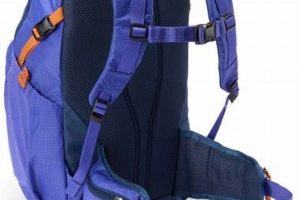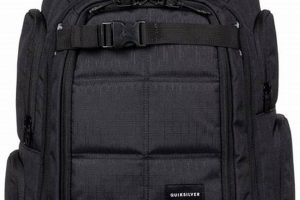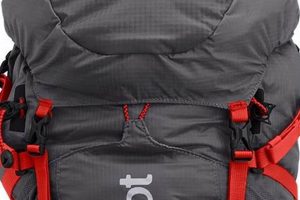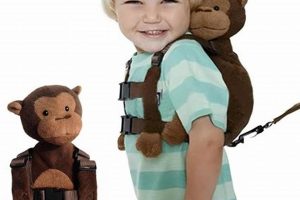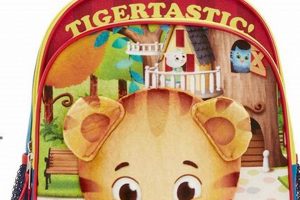These safety devices are designed primarily for young children in busy public areas. They typically involve a small backpack or harness connected to a tether held by a caregiver, preventing a child from wandering off or becoming lost in crowds. A common example is a child wearing a character-themed backpack with a detachable strap for parental control.
Such tools offer increased security and peace of mind for adults responsible for active toddlers or children prone to impulsivity. Historically, methods to keep children close involved holding hands or using stroller restraints. Modern versions provide more freedom of movement for the child while maintaining parental oversight. This is particularly useful in crowded environments, like airports, amusement parks, or shopping centers.
The following sections will delve into the various designs available, safety considerations associated with their use, and factors to consider when selecting the most appropriate option for individual needs and circumstances.
Guidance on the Use of Child Restraint Backpacks
The following recommendations aim to promote responsible and effective utilization of child restraint backpacks, prioritizing safety and convenience.
Tip 1: Prioritize Safety Certification. Before purchase, verify compliance with relevant safety standards, such as those pertaining to strap strength and material toxicity. Certified products undergo testing to minimize potential hazards.
Tip 2: Adjust for a Secure Fit. Ensure the harness or backpack fits snugly but comfortably. Loose straps can create entanglement risks, while overly tight restraints may restrict movement and cause discomfort.
Tip 3: Utilize in Appropriate Environments. Employ these restraints in crowded or potentially hazardous locations where supervision may be challenging. Avoid using them in areas with minimal pedestrian traffic or controlled environments where direct supervision is readily available.
Tip 4: Maintain Visual Contact. Despite the added security, continuous visual monitoring of the child remains paramount. These devices should supplement, not replace, attentive supervision.
Tip 5: Inspect for Wear and Tear. Regularly examine the straps, buckles, and seams for signs of damage or deterioration. Damaged components compromise the device’s effectiveness and may require replacement.
Tip 6: Educate the Child. Explain the purpose of the restraint to the child in simple, age-appropriate terms. Emphasize that it is intended to keep them safe, not to restrict their freedom unduly.
Tip 7: Gradually Introduce Use. If the child is resistant, introduce the device gradually. Begin with short periods of use in familiar settings before transitioning to more challenging environments.
Adhering to these guidelines can help maximize the benefits of child restraint backpacks while minimizing potential risks, contributing to a safer and more manageable experience in public settings.
The subsequent sections will further examine specific product features and selection criteria to aid in informed decision-making.
1. Child's safety
The fundamental rationale for utilizing backpack leashes stems from a commitment to child safety in environments posing potential hazards. The direct correlation is evident: these devices mitigate the risk of a child wandering away from a caregiver in crowded or unpredictable settings. This preventative measure addresses the inherent vulnerability of young children who may lack the cognitive ability to navigate complex surroundings independently, thereby reducing the likelihood of accidents, abduction, or becoming lost. For example, in a bustling airport, a child wearing a backpack leash remains physically connected to their caregiver, preventing them from straying into potentially dangerous areas like moving walkways or escalators. This proactive approach underscores the practical significance of employing backpack leashes to safeguard children in situations where constant direct supervision may be challenging.
Beyond preventing wandering, backpack leashes contribute to child safety by providing a physical link that can be used to prevent impulsive actions. A child who suddenly attempts to run into a street or towards an unfamiliar person can be gently restrained, averting potential harm. The design of the leash and harness also plays a role; features like padded straps and secure closures enhance comfort and prevent accidental detachment. Furthermore, the visibility provided by the backpack itself can make the child more noticeable to others, reducing the risk of accidental collisions in crowded areas. The material selection is likewise crucial, focusing on durable, non-toxic materials that withstand wear and tear without posing a health risk to the child.
In summary, the connection between child safety and backpack leashes is undeniable. They function as a tangible safeguard, minimizing risks associated with wandering, impulsive behavior, and potential hazards in public spaces. While challenges may arise regarding the child’s acceptance of the device or the potential for misuse, a clear understanding of their primary function the enhancement of child safety is paramount. The integration of safety considerations into the design, selection, and responsible usage of backpack leashes ultimately contributes to a more secure environment for young children in potentially dangerous settings.
2. Parental control
Backpack leashes are directly linked to the concept of parental control, representing a physical means for caregivers to maintain proximity and oversight of young children. This connection extends beyond mere restraint, encompassing aspects of safety, management, and peace of mind within challenging environments.
- Proximity Management
Backpack leashes provide a tangible link, allowing parents to keep children within a controlled radius. This is particularly relevant in crowded spaces, such as shopping malls or public events, where the risk of a child becoming separated is elevated. The physical tether enables immediate intervention, preventing the child from wandering into potentially hazardous situations or becoming lost within the crowd. Examples include avoiding a child running into traffic or becoming separated in a busy theme park.
- Mitigation of Impulsive Behavior
Children, particularly those in the toddler and preschool age range, are prone to impulsive actions. Backpack leashes offer a mechanism to gently redirect or halt such behavior, preventing sudden dashes into unsafe areas. This function is not intended as a punitive measure but rather as a safety precaution, akin to a physical safety net that protects the child from their own lack of judgment. An example would be preventing a child from running towards a body of water or into a construction zone.
- Reduced Anxiety for Caregivers
The use of backpack leashes can significantly reduce anxiety for caregivers, particularly those managing multiple children or navigating unfamiliar and crowded environments. Knowing that a child is physically connected allows the caregiver to focus attention more effectively, rather than constantly scanning the environment for a potential runaway. This reduced mental load contributes to a more relaxed and attentive caregiving experience. For instance, a parent managing twins at an airport may use a backpack leash on one child to allow more focus on the other.
- Facilitation of Training and Boundaries
Backpack leashes can serve as a visual cue and a physical reminder to the child regarding boundaries and expected behavior. The tether acts as a tangible representation of the parent’s presence and control, subtly reinforcing the need to stay close and adhere to instructions. While not a substitute for direct communication and positive reinforcement, the backpack leash provides an additional layer of guidance, particularly in situations where verbal commands may be difficult to hear or fully comprehend. This can be especially useful in teaching children to navigate crowded areas safely.
In summary, backpack leashes represent a practical tool for enacting parental control, contributing to child safety and caregiver well-being. Their effectiveness lies in the physical connection they provide, enabling proximity management, mitigating impulsive behavior, reducing anxiety, and facilitating training within diverse and potentially challenging environments. This control is not about domination, but about a temporary safety mechanism for specific situations.
3. Crowded environments
Crowded environments constitute a primary justification for the use of backpack leashes. The inherent risks associated with high-density public spaces directly correlate with the need for increased child supervision and control. Specifically, in environments characterized by significant pedestrian traffic, such as shopping centers, amusement parks, or transportation hubs, the potential for child-caregiver separation escalates dramatically. This separation can result from momentary distractions, impulsive child behavior, or simply the physical challenges of navigating through a dense crowd. The backpack leash, therefore, serves as a preventative measure, mitigating the risk of a child becoming lost or exposed to potentially hazardous situations within these environments. For instance, in a crowded market, a child wearing a backpack leash remains physically connected to their caregiver, precluding the possibility of wandering into a street or being unintentionally separated in the flow of pedestrian traffic. The device provides an added layer of security where environmental factors inherently increase vulnerability.
Furthermore, the design of backpack leashes often incorporates features specifically tailored to the demands of crowded environments. Many models include bright colors or reflective materials to enhance visibility, making the child more easily identifiable amidst a throng of people. Some variations also offer adjustable tether lengths, allowing caregivers to maintain a comfortable degree of control while permitting the child a measure of freedom of movement. The ergonomic considerations are equally crucial. Durable materials and secure fastening mechanisms ensure the leash remains reliably attached, even under the stress of sudden movements or accidental impacts commonly encountered in crowded settings. The effectiveness of the device hinges on its ability to withstand the challenges presented by these environments, necessitating robust construction and thoughtful design elements. For example, the weight of the backpack should be evenly distributed, preventing discomfort or strain on the child’s back and shoulders during extended periods of use in crowded settings.
In summary, the relationship between crowded environments and backpack leashes is causal and practical. Crowded environments necessitate enhanced child safety measures, and backpack leashes provide a tangible means of achieving this heightened level of security. While ethical considerations regarding the appropriate use of such devices persist, their practical value in mitigating risks associated with crowded environments is undeniable. The selection of a suitable backpack leash should, therefore, be informed by a thorough assessment of the specific environmental challenges and the individual needs of the child and caregiver.
4. Freedom of movement
The correlation between freedom of movement and backpack leashes presents a complex dynamic, demanding careful consideration. Backpack leashes, by their very nature, impose a limitation on a child’s unrestricted movement. However, this limitation is often strategically implemented to enhance safety and parental control, particularly in environments where unrestricted movement poses significant risks. The key lies in striking a balance between the child’s need for exploration and autonomy and the caregiver’s responsibility to ensure their well-being. A child allowed to roam freely in a busy urban area risks exposure to traffic, crowds, and potential hazards. A backpack leash, used judiciously, can provide a degree of controlled freedom, allowing the child to explore within a defined perimeter while remaining safely connected to the caregiver. This controlled freedom is not absolute but rather a negotiated compromise designed to mitigate risks while fostering a sense of independence.
The importance of freedom of movement as a component of backpack leashes is paramount. If the restraint is overly restrictive, it can lead to frustration, resistance, and a negative association with the device. Conversely, if the restraint offers too much slack, it negates its intended purpose of maintaining control in potentially dangerous situations. The ideal backpack leash allows for a reasonable range of motion, enabling the child to explore their immediate surroundings without straying beyond a safe distance. Examples include a retractable leash that provides variable length, allowing the child to move more freely in less crowded areas and shortening the tether in high-traffic zones. The design of the harness or backpack itself also contributes to the perception of freedom; comfortable materials, adjustable straps, and a lightweight design minimize discomfort and restriction. Practical applications involve carefully assessing the environment and adjusting the leash length accordingly, allowing the child to lead the way in safe areas and shortening the tether in more hazardous locations.
In conclusion, the relationship between freedom of movement and backpack leashes is one of necessary compromise. The primary function of these devices is to enhance safety, which inherently involves a degree of restriction. However, the effectiveness of backpack leashes hinges on their ability to strike a balance between control and autonomy, allowing the child a reasonable degree of freedom within a safe perimeter. The challenges lie in adapting the leash length and usage to the specific environment and the individual child’s needs, ensuring that the restraint is used judiciously and does not unduly restrict their natural inclination to explore and learn. A thoughtful and nuanced approach to freedom of movement is essential for the responsible and effective utilization of backpack leashes.
5. Age appropriateness
The implementation of backpack leashes necessitates a nuanced understanding of age appropriateness. The suitability of these devices varies significantly across different developmental stages, influencing both the type of restraint employed and the potential benefits derived. Overlooking age-related factors can lead to ineffective usage, discomfort for the child, and potential safety hazards.
- Infants (0-12 months): Unsuitability
Backpack leashes are generally inappropriate for infants. Their limited motor skills and undeveloped musculoskeletal systems make them susceptible to injury if restrained in a manner that restricts natural movement. Furthermore, infants lack the cognitive ability to understand the purpose of a leash, potentially leading to distress and resistance. Standard strollers or carrier devices offer more suitable and developmentally appropriate methods for securing infants in public spaces.
- Toddlers (1-3 years): Potential Benefit with Supervision
Toddlers, characterized by their increasing mobility and tendency for impulsive exploration, represent a demographic where backpack leashes may offer benefits. However, careful consideration must be given to the type of restraint used. Full-body harnesses are preferable to wrist leashes, as they distribute the force of a sudden stop more evenly, reducing the risk of injury. Close supervision remains paramount, and the leash should never be used as a substitute for attentive caregiving. The child’s comfort and willingness to wear the device should be prioritized.
- Preschoolers (3-5 years): Selective Application
Preschoolers typically possess a greater understanding of boundaries and instructions compared to toddlers. Backpack leashes may still be useful in specific situations, such as navigating extremely crowded environments or managing children with attention deficits. However, emphasis should be placed on verbal guidance and reinforcing expected behavior. The leash should be viewed as a temporary aid rather than a constant restraint. Opportunities for independent exploration and decision-making should be encouraged whenever possible.
- School-aged Children (5+ years): Generally Inappropriate
For school-aged children, the use of backpack leashes is generally inappropriate and potentially detrimental to their developing sense of autonomy and self-reliance. At this age, children are typically capable of understanding and adhering to safety rules in public spaces. The use of a leash can be perceived as infantilizing and may negatively impact their social interactions. Alternative strategies, such as clear communication, designated meeting points, and reinforcement of responsible behavior, are more suitable for managing children in this age group.
In summary, age appropriateness is a critical factor in determining the suitability of backpack leashes. These devices are most likely to be beneficial for toddlers, provided they are used judiciously and with close supervision. For older children, alternative strategies that promote autonomy and responsibility are generally more appropriate. The ethical considerations surrounding the use of backpack leashes should always be weighed against the potential benefits, prioritizing the child’s physical and emotional well-being.
Frequently Asked Questions About Backpack Leashes
The following questions and answers address common concerns and misconceptions regarding the use of backpack leashes for children, providing factual information to promote informed decision-making.
Question 1: At what age is a backpack leash most appropriate for use?
Backpack leashes are generally considered most suitable for toddlers between the ages of 1 and 3 years. This age group is characterized by increasing mobility and a tendency for impulsive behavior, making them particularly vulnerable in crowded environments. However, the decision to use a backpack leash should be based on individual child characteristics and parental discretion.
Question 2: Are backpack leashes considered safe for children?
When used responsibly and in accordance with manufacturer instructions, backpack leashes can enhance child safety. However, potential hazards exist, including entanglement risks and the possibility of restricting natural movement. Regular inspection of the device for wear and tear, proper fit, and attentive supervision are essential to mitigate these risks.
Question 3: What are the potential drawbacks of using a backpack leash?
Potential drawbacks include the risk of hindering the child’s development of independence and self-reliance, as well as the potential for social stigma. Additionally, if used improperly, the leash could create a false sense of security, leading to lapses in parental supervision. Careful consideration should be given to these potential negative impacts before implementing a backpack leash.
Question 4: What features should be considered when selecting a backpack leash?
Key features to consider include the material’s durability and non-toxicity, the security of the fastening mechanisms, the adjustability of the straps and tether length, and the overall comfort of the design. Bright colors or reflective elements can also enhance visibility in crowded environments. Compliance with relevant safety standards is paramount.
Question 5: Are there alternative methods to using a backpack leash for child safety?
Alternative methods include maintaining constant visual contact, holding the child’s hand, utilizing strollers or carriers, and providing clear instructions regarding safety rules in public spaces. The choice of method should be based on the child’s age, developmental stage, the environment, and parental preferences. Combining multiple strategies may be most effective.
Question 6: What are the ethical considerations surrounding the use of backpack leashes?
Ethical considerations include the potential for dehumanization and the impact on the child’s sense of autonomy. While safety is paramount, it is important to balance the need for control with the child’s right to explore and develop independence. Open communication with the child, explaining the purpose of the leash and respecting their feelings, is essential.
In summary, the responsible and informed use of backpack leashes requires careful consideration of age appropriateness, safety factors, potential drawbacks, and ethical implications. Alternatives should be explored, and the decision to use a backpack leash should be based on individual circumstances and parental judgment.
The subsequent section will explore real-world scenarios and case studies related to the use of backpack leashes.
Backpack Leashes
The preceding analysis has explored the diverse facets of backpack leashes, encompassing their functionality, appropriate usage parameters, potential drawbacks, and ethical considerations. These devices serve as a tangible means of enhancing child safety, particularly within crowded environments, by providing a physical link between caregiver and child. However, their deployment necessitates a careful assessment of age appropriateness, individual child characteristics, and the specific environmental context. The balance between parental control and a child’s need for freedom of movement remains a critical factor in responsible utilization.
Ultimately, the decision to employ backpack leashes should stem from informed deliberation, weighing the potential benefits against the possible negative impacts on a child’s development and sense of autonomy. Continuous vigilance, coupled with proactive safety measures and open communication with the child, remains paramount. Further research is warranted to assess the long-term psychological effects of using such restraints, ensuring that child safety measures align with developmental needs and ethical considerations.



